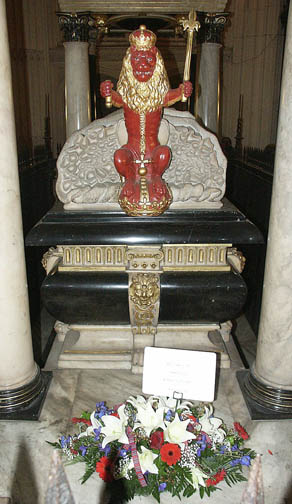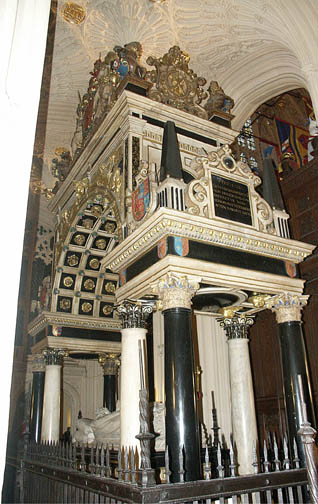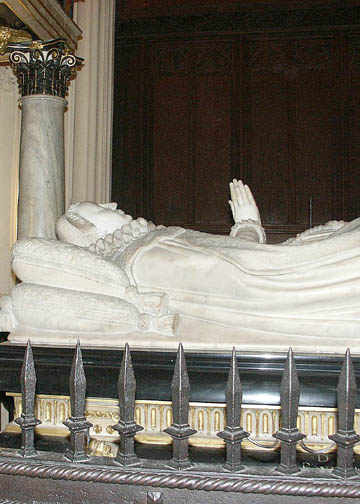Saturday, 8th December 2002
 The gathering of Society members was met by a gowned Verger and a Sub-Canon of the Abbey, Canon
Middleton, and they led the procession from the nave down the south
nave aisle, followed by Lola proudly carrying the flowers, and the
rest in twos.
The gathering of Society members was met by a gowned Verger and a Sub-Canon of the Abbey, Canon
Middleton, and they led the procession from the nave down the south
nave aisle, followed by Lola proudly carrying the flowers, and the
rest in twos.
The Canon welcomed members, remarking upon the remarkable red painted
Scottish lion which sits on hind legs carrying a golden orb and
sceptre, at Mary's feet. He then invited Margaret Lumsdaine, President of the Society, to say a few words.
This is the transcript, but please remember that this is written to
be said and not read, therefore with emphasis on certain words it
would come over quite differently.
"It is always a great pleasure for me to arrive at Westminster Abbey
in December and to meet up with members and friends of the Marie
Stuart Society. Thank you for coming to our ceremony today to
remember Mary, Queen of Scots and to lay flowers at her tomb. And my
sincere thanks to the Abbey and Chapter of Westminster for allowing
us the privilege of this ceremony each year, and to yourself Canon
Middleton for welcoming us today on behalf of the Chapter.
In the closing weeks of this our Queen Elizabeth's Jubilee year we
rejoice knowing that Her Majesty has enjoyed 50 years on the throne
of Great Britain, and we certainly wish her many more years as our
Monarch.
 But what of her famous ancestor, Mary? She may have been Queen in
Scotland for 43 years but she reigned in her own right for only six
of these years. These were six turbulent years for her and
discussion will always be rife as to whether she was a good monarch
or a bad one. Our Society exists to study this period in British
history, not to judge it. In our study we find that this was perhaps
one overruling quality in the life of Queen Mary. She did not judge
anyone. Not even her staunch protagonist Mr. John Knox, nor did she
deliberately set out to judge her cousin Queen Elizabeth Tudor. This
young woman of 19 years, as she was when she returned to her native
land in 1561, was beset by many trials and tribulations at a time
when the nations of Europe were faced with a reforming religion. Mary
was a Roman Catholic by birth and upbringing and the land she came to
rule personally in 1561 had become, by proposal of Parliament, a
Protestant nation. The tolerance which she showed towards the 'new'
religion showed that Mary accepted change without compromising her
own beliefs. It is a pity that many of her fellow countrymen did not
show the same tolerance towards her, citing her religion as the
weapon to use against her person. Scholars will always debate why
she crossed the border into England to look for help and safety. But
the one one thing which needs no debate is that in this land of
England she did find safety. Maybe, though, not of the kind she
would have chosen for herself; and that she did show great courage
and tolerance in adversity.
But what of her famous ancestor, Mary? She may have been Queen in
Scotland for 43 years but she reigned in her own right for only six
of these years. These were six turbulent years for her and
discussion will always be rife as to whether she was a good monarch
or a bad one. Our Society exists to study this period in British
history, not to judge it. In our study we find that this was perhaps
one overruling quality in the life of Queen Mary. She did not judge
anyone. Not even her staunch protagonist Mr. John Knox, nor did she
deliberately set out to judge her cousin Queen Elizabeth Tudor. This
young woman of 19 years, as she was when she returned to her native
land in 1561, was beset by many trials and tribulations at a time
when the nations of Europe were faced with a reforming religion. Mary
was a Roman Catholic by birth and upbringing and the land she came to
rule personally in 1561 had become, by proposal of Parliament, a
Protestant nation. The tolerance which she showed towards the 'new'
religion showed that Mary accepted change without compromising her
own beliefs. It is a pity that many of her fellow countrymen did not
show the same tolerance towards her, citing her religion as the
weapon to use against her person. Scholars will always debate why
she crossed the border into England to look for help and safety. But
the one one thing which needs no debate is that in this land of
England she did find safety. Maybe, though, not of the kind she
would have chosen for herself; and that she did show great courage
and tolerance in adversity.
Mary was close in line to the English throne and always looked to
unite these two nations through her own person or that of her son.
We all know the outcome of her aspirations, and that James, her son,
united the two kingdoms in 1603 when Queen Elizabeth named him as her
successor.
James, who did not really know his mother and had never seen her
since he was a baby, honoured her by having her remains brought to
the Abbey and placed beneath this beautiful memorial, very close, in
fact, to her cousin Elizabeth, who rests but a few yards away. Here
in this beautiful Abbey where successive monarchs have been crowned,
Mary rests in peace and has witnessed the outcome of her desire to
unite two warring kingdoms into one Great Britain.
It is in tribute to her vision that we come today to lay flowers at
the tomb of one who could rightly be remembered as the mother of
Great Britain.
Lola, I have pleasure in asking you to place these flowers."
Lola, at this point laid the flowers inside the railings surrounding
the monument.
"And after this happy little ceremony, Juliet Wilson will now read
Queen Mary's prayer, written in adversity. A modern prayer, showing
an understanding of God's love for us all, however we may choose to
worship".
 Juliet read the following prayer:
Juliet read the following prayer:
Keep us, O God from all pettiness.
Let us be large in thought, in word, in deed.
Let us be done with fault-finding and leave off all self-seeking.
May we put away all pretence and meet each other face to face, without
self pity and without prejudice.
May we never be hasty in judgement, and always be generous.
Let us always take time for all things, and make us to grow calm,
serene and gentle.
Teach us to put into action our better impulses, to be straightforward
and unafraid.
Grant that we may realise that it is the little things of life that
create differences, that in the big things of life, we are as
one.
And, O Lord God, let us not forget to be kind!
Amen.
Photos courtesy of Roger Joy.
| How to join | What's On? | Members Only | Office-bearers | Newsboard |